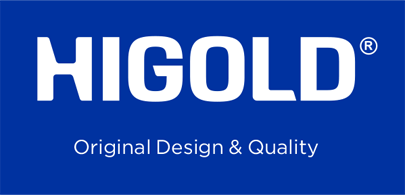In modern kitchen design, white quartz sinks are popular for their clean, simple, and elegant appearance.
Whether paired with light-colored cabinets or a modern minimalist countertop, a white quartz sink creates a fresh and clean feel.
However, with prolonged use, many users encounter a frustrating problem:
"My white quartz sink has turned yellow and darkened, what should I do?"
"How can I restore the whiteness of my white quartz sink?"
This article will analyze the reasons for discoloration of white quartz sinks, the cleaning principles, restoration methods, and daily protection tips, helping you step-by-step restore your sink's original bright white shine.
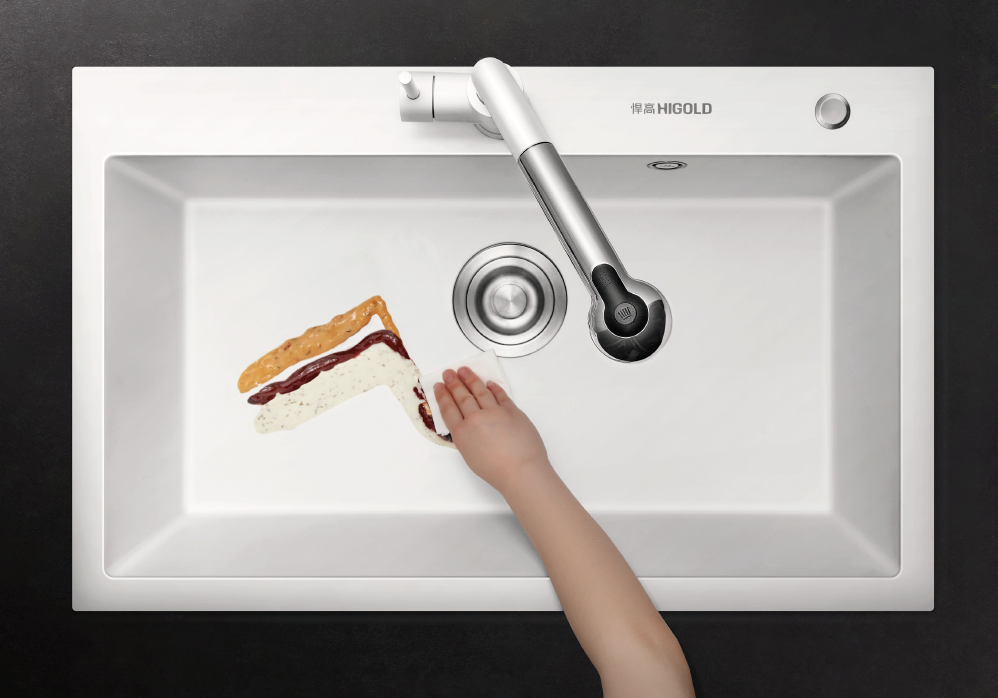
Why do white quartz sinks turn yellow and darken?
The main components of a white quartz sink are natural quartz particles (approximately 70%-80%) + resin (approximately 20%-30%).
Quartz itself is stable and does not easily discolor, but the resin component is easily contaminated, oxidized, or yellowed by heat during long-term use.
Here are some common discoloration issues and their causes:
1). Long-term accumulation of kitchen stains
Oil splattered from washing vegetables, dishes, and pouring out leftover soup, coffee, tea stains, sauces, etc., can adhere to the surface of the sink or into its tiny pores.
If not cleaned promptly, these organic substances can seep into the quartz resin layer, causing yellowing or dull areas.
2). Scale buildup
Tap water contains calcium and magnesium ions, which, after prolonged use, will form white or gray carbonate deposits on the surface.
This scale will reduce the shine of a white quartz sink, making it appear dull and lackluster.
3). Cleaning agent residue and chemical reactions
Many strong acidic or alkaline cleaning agents can react chemically with the resin layer on the quartz surface, causing a slight color change.
For example, excessive use of disinfectant containing bleach can cause localized yellowing or graying.
4). Long-term exposure to heat and ultraviolet light
If the sink is frequently exposed to hot cookware or direct sunlight, the resin will age due to heat and turn pale yellow.
5). Lack of Regular Maintenance
While white quartz sinks are hard, their surface is not completely sealed.
Without regular cleaning, fine dirt can become embedded in the pores, causing them to appear darker.
Discoloration of a white quartz sink is not caused by a single factor, but rather by a combination of factors including dirt, chemical reactions, limescale buildup, and thermal aging.
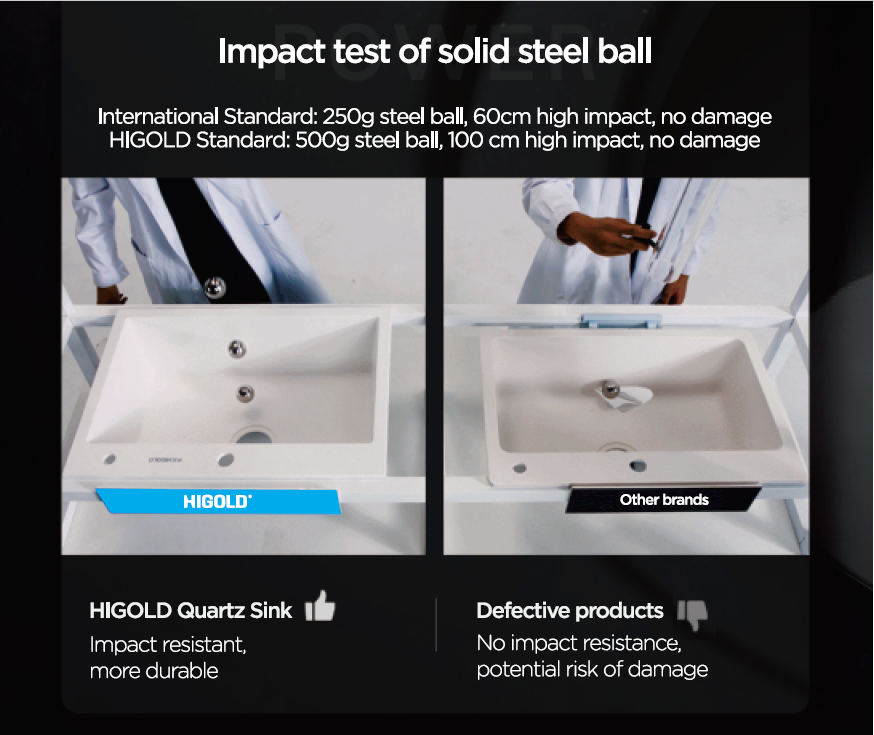
Can a white quartz sink be whitened again?
Many people worry that "a yellowed white quartz sink can never be washed white again." This concern is not entirely unfounded.
Yellowing or darkening of a white quartz sink is mostly due to surface contamination or mild oxidation, rather than changes in its internal structure.
Therefore, with proper cleaning and maintenance, it can be restored to a near-original white shine.
The key is—using suitable cleaning materials, following scientific procedures, and maintaining the correct frequency.
Next, we will detail how to whiten a white quartz sink for different degrees of discoloration.
Slight Yellowing: How to restore the brightness of a white quartz sink through daily cleaning?
If your white quartz sink is only slightly dull or yellowed, it can be improved with regular cleaning.
1. Clean with warm water and neutral detergent
First, mix a small amount of neutral detergent with warm water (around 40℃) and wipe with a soft sponge or cloth.
This method effectively removes grease and everyday grime.
✅ Note: Avoid using steel wool or hard brushes to prevent scratching the resin layer.
2. Clean with baking soda paste
Baking soda (sodium bicarbonate) is a mild alkaline substance that neutralizes acidic stains.
How to use:
• Mix baking soda powder with a small amount of water to form a paste;
• Apply evenly to the yellowed areas;
• Let it sit for 15 minutes;
• Wipe clean with a damp cloth, then rinse with water.
This method removes shallow stains such as tea and coffee stains, restoring the original shine to the white quartz sink.
3. Remove limescale with white vinegar
If the discoloration is due to limescale buildup, add white vinegar during the cleaning process.
Ratio: Mix white vinegar and water in a 1:1 ratio, spray onto the sink surface, let stand for 10 minutes, then scrub.
The weak acidity of white vinegar effectively dissolves calcium and magnesium ion deposits.
4. Rinse thoroughly with clean water
After cleaning, be sure to rinse thoroughly with plenty of water and dry with a clean towel to prevent residual cleaning agent from causing further discoloration.
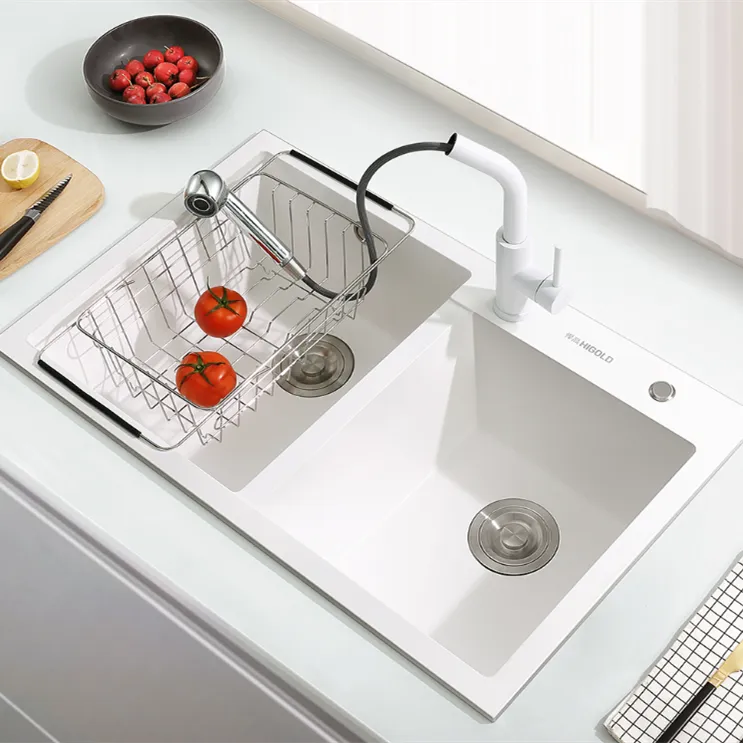
Moderate yellowing: How to deep clean a white quartz sink?
If the white quartz sink has obvious yellow stains or oil spots, daily cleaning alone is insufficient to remove them. In this case, "deep cleaning" is required.
1. Use oxygen-based bleach (non-chlorine bleach)
Oxygen-based bleach (such as sodium percarbonate) gently breaks down organic stains without damaging the quartz structure.
Instructions for Use:
• Dissolve 1-2 tablespoons of bleach in 2 liters of warm water;
• Pour into the sink and let stand for 30 minutes;
• Wipe with a soft sponge, then rinse thoroughly with clean water.
⚠️ Note: Avoid using chlorine-based bleach (such as 84 disinfectant), as this may cause the resin layer to yellow.
2. Use toothpaste and a sponge for light polishing
Toothpaste contains micro-abrasive particles that can lightly polish the surface.
Squeeze a small amount of toothpaste onto the yellow stain, rub in circular motions with a sponge, then clean with a damp cloth.
This method is particularly suitable for "tableware scratches" and "slight color differences."
3. Use lemon juice or citric acid solution
Citric acid effectively breaks down stubborn limescale and oxides.
Apply lemon juice to the stain, let it sit for 20 minutes, then wipe clean for a noticeable brightening effect.
Severe Discoloration: How to Thoroughly Renovate a White Quartz Sink
When a white quartz sink has been used for many years and its surface is severely yellowed, dull, or has stubborn oil stains, a more effective treatment is needed.
1. Use a Professional Quartz Sink Cleaning Paste
There are cleaning or polishing pastes specifically designed for quartz sinks available on the market. These contain gentle abrasives and active ingredients to remove deep-seated stains.
Steps:
• Apply evenly to the sink surface;
• Wipe repeatedly with a soft cloth or sponge for 2-3 minutes;
• Rinse with clean water and dry.
This method can significantly improve uneven surface color.
2. Use Hydrogen Peroxide Immersion Method
For areas with severe pigmentation, a 3% hydrogen peroxide solution can be used for oxidative bleaching.
Steps:
• Soak a towel in hydrogen peroxide and cover the discolored area;
• Let it sit for 1 hour;
• Remove the towel and rinse thoroughly with clean water.
Hydrogen peroxide can break down organic pigments, restoring the surface to its original whiteness.
3. If the surface is severely worn, light polishing can be performed for repair
A professional can use a quartz countertop polisher to micro-polish the surface (within 0.1mm).
This effectively removes the oxide layer and old dirt, restoring the white quartz sink's shine.
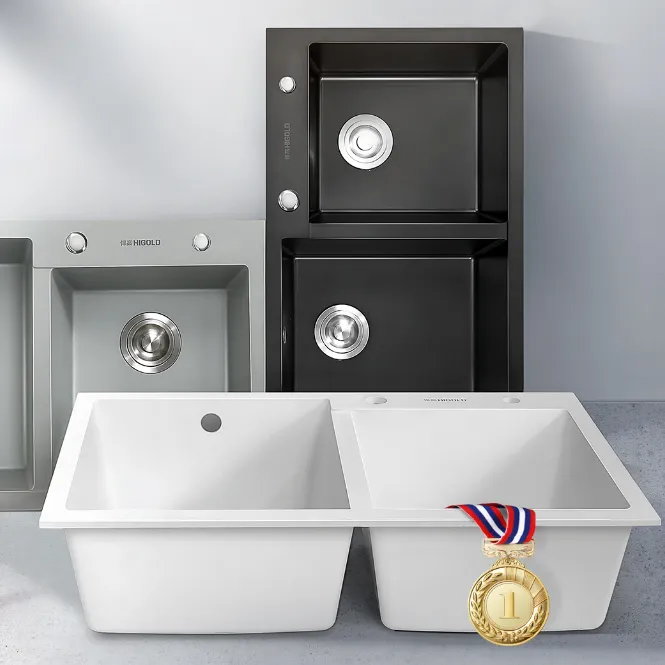
Why do some cleaning methods make white quartz sinks yellower after washing?
Many people try to clean them with "strong detergents" or "bleach," but the results are counterproductive.
This is because certain ingredients react chemically with the resin on the surface of the quartz sink.
1. Chlorine bleach (such as 84 disinfectant)
Chlorine oxidizes the resin, causing it to darken or yellow.
2. Strong acid cleaners
These corrode the resin layer, dulling the surface and attracting more dirt.
3. Metal brushes or sandpaper
These damage the protective layer, making it easier for subsequent stains to adhere.
Correct Practice: Always use neutral or mildly alkaline detergents and avoid strong mechanical friction.
How to prevent white quartz sinks from yellowing again?
After restoring their whiteness, maintaining their bright whiteness is even more important.
Here are professional maintenance suggestions:
1). Daily Cleaning
Use neutral detergent with warm water to clean, and dry immediately afterward.
2). Weekly Deep Cleaning
Wipe once a week with a baking soda paste or white vinegar solution to prevent dirt buildup.
3). Avoid Direct Contact with Hot Cookware
High-temperature cookware may cause discoloration or localized yellowing of the resin surface.
4). Prevent Staining Liquids from Residue
If coffee, soy sauce, red wine, etc., are spilled, wipe them dry immediately to prevent them from seeping into the pores.
5). Keep Dry
Dry the sink promptly after use to avoid prolonged dampness that can cause limescale buildup.
Can I use bleach on a white quartz sink?
It is recommended to use an oxygen-based bleach (such as sodium percarbonate), and avoid using chlorine-based bleach. Chlorine bleach will make the sink yellower with repeated washing.
Can I use scouring powder?
Scrubbing powder may contain abrasives that can scratch the resin layer. Unless specifically designed for quartz, it's not recommended.
What should I do if there are scratches on the surface of my quartz sink?
Minor scratches can be polished with toothpaste; for deep scratches, it's recommended to have a professional clean it.
My white quartz sink is turning gray; is it broken?
No. It's usually caused by an oil film, limescale, or cleaning agent residue. Cleaning will restore its original appearance.
Can I use a steam cleaner?
Yes, but the temperature should not exceed 90℃ to avoid thermal expansion and contraction that could cause micro-cracks.
Comparison of Stain Resistance Between White Quartz Sinks and Other Materials
Material Types | Stain resistance | Is it prone to discoloration? | Cleaning difficulty | Maintenance Frequency |
| White Quartz Sink | ★★★★☆ | Medium to low | Medium | Deep cleaning once a week |
| Stainless Steel Sink | ★★★☆☆ | Does not discolor but easily scratched | Easy | Daily cleaning is sufficient |
| Composite Granite Sink | ★★★★★ | Extremely difficult to discolor | Relatively easy | Maintenance once a month |
| Ceramic Sink | ★★★★☆ | Not prone to discoloration | Simple | Wiping once a week |
As can be seen from the table, although white quartz sinks have a pure color, they are indeed more prone to staining and require more meticulous daily maintenance.
How does Higold maintain production efficiency?
Higold integrates advanced automation with digital factory management, enabling real-time monitoring and optimization of production lines. This ensures high efficiency, consistent output, and reliable delivery for bulk orders.
Wholesale buyers and distributors benefit from short lead times, accurate supply schedules, and stable prices. Our modern factory setup makes us a competitive manufacturer in the global market.
